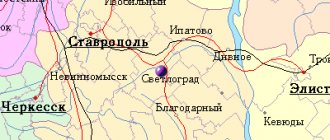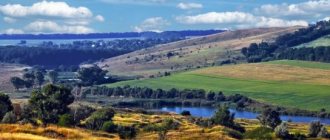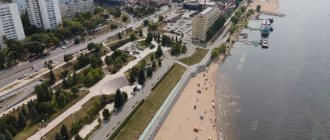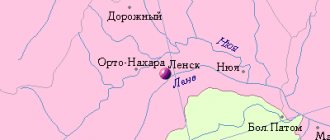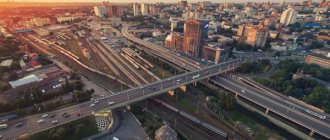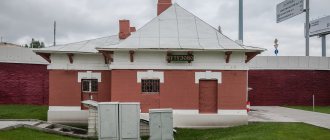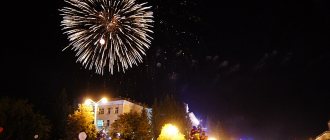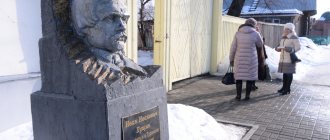Kinel
In 922, a caravan of the embassy of the Baghdad caliph passed through the Trans-Volga steppes in the direction of the Bulgarian kingdom. Subsequently, the secretary of the embassy, Ahmed Ibn Fadlan, based on the results of this trip, wrote a treatise called “Risale” (translated into Russian as “Notes”). And here, on the pages of his work, you can find the very first literary mention of the Kinal River, which flows through the Middle Trans-Volga region and flows into the Samur River. Nowadays we know these rivers under the names Bolshoy Kinel and Samara (Fig. 1).
By the name of the river
As stated in the book “Samara Toponymy” (authors V.F. Barashkov, E.L. Dubman and Yu.N. Smirnov), the word “Kinel” has its origins in Turkic languages. And further it is said: “Compare the Tatar “kin” - “wide”, “widely”, “kinya” - “to expand, expand, increase”, “kineyule” - “expandable”. In Turkic languages, the common nouns “el”, “el” are known in the meaning of “river”, “river path”. Hence Kinel - “a wide, expanding (during flood) river.”
Over the centuries that have passed since Ahmed Ibn Fadlan's journey across the Volga region, many different villages and hamlets have appeared on the banks of the Kinel River. Among them, in the early 30s of the 19th century, 40 versts from the district town of Samara, the small settlement of Studenets was founded, at first consisting of only 18 households of appanage peasants. The settlers liked the abundance of meadows and pastures in these places, almost untouched floodplain forests and numerous lakes rich in fish and waterfowl, and several more villages were founded along the banks of the Kinel - Charykovka, Skolkovo, Bogdanovka, Georgievka, Pokrovka, Veretyaevka, Krivaya Luka, and others (Fig. 2-8).
Since a busy postal road ran very close to the new settlement, connecting the cities of Samara and Orenburg, the village of Students quickly began to grow and develop. It was in its place that a roadside settlement arose in 1837, which was named Kinel after the river flowing nearby. In 1851, it found itself within the vast Samara province created by decree of Emperor Nicholas I.
In 1859-1860, already under the next sovereign Alexander II, large railway construction began in the Russian Empire. At the same time, cast iron rails could reach the banks of the Volga, namely the Syzran station, only after 15 years. Although at that time the railway bridge across the Volga was still just being designed, construction of the Orenburg Railway began already on February 22, 1874. Work proceeded simultaneously in several areas, which were put into temporary operation as soon as they were ready. Peasants from the Simbirsk, Samara and Orenburg provinces were involved in the construction. As a result, permanent traffic on this line through Samara and Kinel to Orenburg with a length of 507.3 versts opened on January 1, 1877 (Fig. 9-23).
Later, from the Kinel station, construction began on another branch of the rail track in the direction of Ufa, which then went to the Southern Urals, to the city of Zlatoust. This is how the Samara-Zlatoust Railway began, on which the Kinel station became one of the largest transport hubs in 1888. From that moment on, the life of a significant part of the local population became inextricably linked with the work of the steel highway passing through the village. Even then it was possible to talk about the railway as a city-forming industry for this settlement (Fig. 24-26).
After 1895, the neighboring village of Charykovka, named after the owner of the land on which the railway station was built, also became part of the station village of Kinel. According to the population census held on January 28, 1897, the total number of residents of Kinel exceeded 1,700 people. In 1903, an agricultural school was opened on its outskirts (later the Samara Agricultural Institute), and as a result, by 1910 the number of residents of the village reached 3 thousand people.
In 1916, Kinel was given the status of a 1st class railway station. This meant that from that moment it became one of the largest transport interchanges in Russia in pre-revolutionary times (27-36).
Fiery tragedy
However, shortly before this event, the Kinel railway junction became the victim of a terrible fire. According to newspapers of that time, at 3 o'clock in the afternoon on June 21, 1911, a barn caught fire in the station area, and within half an hour, houses on two neighboring streets were blazing. Meanwhile, all the equipment of the local fire brigade then consisted of only two pumps and two horse-drawn barrels, and, of course, the Kinel firefighters could do little in this situation. As a result, after just over an hour, the fire spread across the tracks to the other side of the village.
When the railway station caught fire, an unimaginable panic began in Kinel. Soon the trading shops adjacent to the station, the freight cars standing on the tracks, as well as the stacks of tarred sleepers prepared for repair were already ablaze. Moreover, at the very height of the disaster, even those sleepers on which the rails of the existing railway line lay, along which, by the way, trains from St. Petersburg and Moscow via Samara lay to Central Asia, ignited.
By 8 o'clock in the evening, a fire train, commanded by the head of the railway himself, arrived from Samara to Kinel. However, by that time the fire had already begun to subside. For the rest of the evening and throughout the night, the rescuers who arrived mainly extinguished only the smoking ruins. The fire stopped completely only by the morning of the next day (Fig. 37-41).
It is gratifying that during the fight against the fire, railway workers and a group of firefighters managed to defend the station building, which had recently been built of stone. However, almost all the other buildings in Kinel before the fire were wooden, and, of course, they were completely swallowed up by the fiery element that terrible evening. In total, out of 530 buildings that were registered in this village before June 21, 1911, only 26 remained intact, including the already mentioned station, a local church and... a wine shop. But the post office burned down, where a large sum of money was kept.
According to the provincial police, as a result of that tragedy in Kinel, more than a dozen people died, and one deceased person also burned to death, whose relatives were unable to take him out of the house that caught fire. During the fire, 2,445 cows and 2,235 small livestock were killed, and 3,265 people lost their homes.
By order of the head of the railway, the legality of which was fully confirmed by the Minister of Railways, the movement of trains through the Kinel station was delayed for almost a day. All this time, the repair team that arrived from Samara was restoring the burnt sleepers and replacing the rails, which in many places were crumpled by the raging flames. And during all the repair work, Kinel residents who lost their homes walked along the cars of stopped trains and begged for alms. To be fair, it should be said that they were willingly served, not only the next day after the tragedy, but also for a long time, when, after the resumption of railway traffic through Kinel, passing trains stopped here (Fig. 42).
In general, the Kinel tragedy forced Russian and provincial authorities to pay more attention to the planning and fire safety of not only large cities, but also small settlements. A number of financial and construction benefits introduced by government decision for residents of the affected cities also helped. As a result, by 1913 Kinel had almost completely risen literally from the ashes. However, the outbreak of the First World War and the revolutionary events of 1917 delayed the process of their restoration for a long time.
Soviet years
During the first decade of Soviet power, no new facilities were built on the railway, as throughout the country, due to devastation and economic chaos. The railway workers only had enough strength and resources to maintain in working order the structures, lines and rolling stock inherited from Tsarist Russia. Only at the end of the 20s, when the first five-year plan for the development of the national economy of the USSR was adopted, new railway and housing construction began in Kinel for the first time after the revolutionary events and civil war. During this period, during the largest administrative-territorial reform in the USSR, by a resolution of the All-Russian Central Executive Committee of July 16, 1928, the Kinelsky district was allocated as part of the newly formed Middle Volga region (with its center in the city of Samara). A year later, the Middle Volga region was renamed the Middle Volga region. Soon after this, by a decree of January 30, 1930, the district center of Kinel was classified as a workers' settlement.
According to the population census, on May 1, 1931, there were already about 8,300 residents in Kinel. This station settlement included the microdistricts of New Students, Agricultural Institute (Agricultural Institute), Sovety, Rechka, Gorny, Mozharo-Minaevsky, Ivan-Chasy (Elshnyagi), Lebed. The village continued to develop, and in 1939 its population was already 17,160 people.
During the Great Patriotic War, the regional center of Kinel played a huge role in the uninterrupted delivery of personnel and weapons for the Red Army, as well as ammunition, food, ammunition and other military cargo to the fronts. During difficult times of war, its population mainly concentrated near the station, building houses on its northern and southern sides. During the same period, the status of the settlement changed radically, when by the Decree of the Presidium of the Supreme Soviet of the RSFSR dated March 16, 1944, the workers' village of Kinel was transformed into a city of regional subordination with the same name. After the publication of this Decree, the executive committee of the Kinel City Council of Workers' Deputies was elected.
As the railway economy developed, the urban economy also developed. In 1957, after its own asphalt plant was built in Kinel, the roads on the city streets began to be gradually covered with asphalt. In the early 60s, since the construction of the road bridge across the Kinel River in the Agricultural Institute area, the highway at the exit from Kinel, as well as in the direction of Kuibyshev and Otradny, was paved. Asphalt roads were also built in the direction of the villages of Bobrovka and Malaya Malyshevka. In 1958, after the appearance of good paved roads in the area, a motor transport enterprise was created in Kinel, which began organizing regular bus traffic within the city, as well as intercity communication to Kuibyshev, to the village of Malaya Malyshevka and on other routes.
By the beginning of 1963, the city's population had grown to 35 thousand people. At the same time, in accordance with the Decree of the Presidium of the Supreme Soviet of the RSFSR dated February 1, 1963, Kinel was transformed into a city of regional subordination. Since that time, the main place of work for local residents has remained the Kinel railway junction (Fig. 43-52).
By decision of the executive committee of the Kuibyshev Regional Council of Workers' Deputies dated October 15, 1976 No. 687, the city limits of Kinel were established, as a result of which the total area of the city increased to 5288 hectares. Currently, the administrative boundaries of the Kinel urban district include the Lebed, Elshnyagi, Gorny microdistricts, the village of Alekseevka, the village of Ust-Kinelsky with the settlements of Students, Sovety, and Melnitsa.
According to 2015 data, the population of the city of Kinel is 34.4 thousand people, but the population of the entire urban district is 51.051 thousand people. Within the boundaries of the urban district, local self-government is exercised, which is a form of democracy that provides the population of Kinel with the opportunity to independently and under their own responsibility resolve issues of local importance. The elected bodies of local government in the city are the Duma of the Kinel urban district and the head of the city district. The executive body of city government is the administration of the Kinel city district.
Present day
Nowadays the city of Kinel is considered one of the most unique cities and municipalities not only in the Samara region, but also in Russia as a whole. Its territory has developed an economic base unique in its diversity and significance, represented by a powerful railway junction, an interregional center for agricultural science and personnel training, as well as one of the largest pig-breeding complexes in Russia in combination with a feed mill.
As already mentioned, Kinel is a large railway junction - an after-school marshalling station. Until the early 90s, Kinel was one of the 100 decisive marshalling stations of the Ministry of Railways of the Soviet Union.
The Kinelsky railway junction includes a station with seven train reception and departure parks, a large out-of-class locomotive depot, a carriage depot, a track distance, a signaling and communication distance, a distance of civil structures, a traction substation of the contact network, and a track machine station that provides major repairs of the track. The Kinel station operates in four directions, connecting the flow of cargo and passenger traffic: Ural-West, Central Asia-Centre. The passenger departure rate is approximately 2 million passengers per year. The average annual number of workers on the railway is more than 4 thousand people (Fig. 53-55).
The main industries of the city are food and production of building materials. In terms of output of consumer goods per capita, Kinel now consistently ranks sixth among the cities of the Samara region.
Enterprises of the Kinel urban district produce the following products:
JSC "Bread Factory" - bread, bakery products;
JSC "Dairy Factory" - whole milk products (butter, cheeses, sour cream, etc.);
JSC “Pishchevik” – mayonnaise, soft drinks, confectionery;
JSC "Alekseevsky" - meat - pork, sausages;
JSC Kinelagroplast – plastic components for VAZ, gaskets for engines.
On the territory of the urban district of Kinel, in the village of Ust-Kinelsky, is located one of the oldest universities in our region - the Samara State Agricultural Academy (SGAA). Its history dates back to 1919, when the Faculty of Agriculture was formed as part of Samara State University. In 1922, it became an independent university called the Samara Agricultural Institute (SHI). In 1995, Agricultural Institute was transformed into the Samara State Agricultural Academy (Fig. 56-67).
Nowadays this university is the only representative of Russia in the Association of Agricultural Educational Institutions of Europe. The university occupies one of the leading places in Samara in terms of the number of foreign internships for its students. The geography of his international connections is wide: France, Holland, Germany, Hungary, Denmark, Switzerland. An International Center for training and consulting farmers has been organized at the Academy.
The Academy provides training in seven specialties (agronomy, animal science, agricultural mechanization, veterinary medicine, technology for processing and storing agricultural products, economics and management of agricultural production) at five faculties. The Academy's correspondence faculty trains personnel in all major specialties. Over the years of the Academy's existence, more than 30 thousand specialists have been trained for the national economy of the country. The educational process at the academy is conducted by 32 departments and 6 branches of departments. The Academy employs over 250 teachers, including 28 doctors of science and professors, as well as 140 candidates of science (Fig. 68-73).
In 2013, the XV Volga region agro-industrial exhibition was held in the village of Ust-Kinelsky, in which enterprises and organizations of the agro-industrial complex of the Samara region, enterprises and organizations of the Moscow, Leningrad, Yaroslavl, Belgorod, Volgograd, Smolensk, Saratov, Penza, Novosibirsk and Orenburg regions took part, as well as the republics of Mordovia and Tatarstan. Guests from Ukraine and Belarus visited our urban district. Among the participants are research and educational institutions, manufacturers of agricultural machinery, fertilizers, feed, plant protection products, investment and insurance companies, large agricultural and processing enterprises, peasant farmers and personal subsidiary plots. Holding such exhibitions has already become a good tradition for Kinel (Fig. 74-81).
In the second half of the twentieth century, in the urban district of Kinel, the sphere of trade, public catering and consumer services developed significantly. The district House of Public Services, built in the 70s, was privatized in post-Soviet times and still serves visitors (Fig. 82-84).
The Kinel healthcare system has accumulated a lot of positive experience. The city has a central regional hospital with a total bed capacity for 145 people, and a clinic with a capacity of 500 visits per shift.
In addition to municipal medical institutions, the city has a departmental hub hospital with an inpatient department (160 beds) and an outpatient department (7 thousand attached population). This hospital has surgical (traumatology), therapeutic, and children's departments.
The Kinel education system currently includes 14 schools (more than 7 thousand students), 13 preschool educational institutions (over 1.3 thousand children), two vocational schools (about 800 students), five additional education institutions (almost 3.5 thousands of people).
In the village of Ust-Kinelsky there is an innovative educational institution - a lyceum (7 classes, more than 200 students), co-founded by the Agricultural Academy. Training is conducted for grades 9-11 in chemical-biological and physical-mathematical areas. Admission to the lyceum is carried out on a competitive basis.
There are cultural institutions in the city, including the city house of culture (DC) in Kinel, the cultural center of the Agricultural Academy in the village of Ust-Kinelsky, and the cultural center in the village. Alekseevka. About 30 amateur art groups work in existing cultural centers. The city's centralized library system consists of eight libraries, two of which are children's. There are also four music schools in Kinel, where more than 400 children study. Training is provided on a paid basis, but a 50 percent discount is provided for children of low-income families. Music school students take part in city and regional competitions.
Back in 1970, on the 25th anniversary of Victory Day in the Great Patriotic War, a Victory Park with an obelisk was founded in Kinel in memory of the fellow countrymen who died at the fronts. The obelisk was a truncated 4-sided pyramid with a five-pointed star on top and a bas-relief image of the Golden Star of the Hero of the Soviet Union on the front side. In 1985, Victory Park was reconstructed. Today the obelisk looks like a beautiful composition of three rifle bayonets pointing upward, at the base of which the Eternal Flame burns.
In the village of Alekseevka, Kinel urban district, on May 7, 1995, the monument “Maternal Valor” was unveiled, dedicated to the Volodichkin family. Before the Great Patriotic War, a family lived here as follows: the head of the family, Pavel Vasilyevich Volodichkin, his wife Praskovya Eremeevna Volodichkina, and their nine sons - Alexander, Andrey, Peter, Ivan, Vasily, Mikhail, Konstantin, Fedor and Nikolai. Pavel Vasilievich died in 1935. When the war began, all nine Volodichkin sons went to the front. Five of them, Nikolai, Andrei, Fedor, Mikhail and Alexander, died in 1941-1943, and Vasily in January 1945. Peter, Ivan and Konstantin returned to the village after the victory with severe wounds received during the war, which soon brought them to their graves. Their mother, Praskovya Eremeevna, did not wait for her last three sons to return from the front and died in 1943. Her heart could not stand such losses.
Nowadays, it is possible to maintain the monument in proper condition thanks to the help of the Alekseevsky utility plant and the voluntary care of the village residents (Fig. 85-97).
Valery EROFEEV.
Bibliography
150 years of Samara province (figures and facts). Statistical collection. Ed. G.I. Chudilina. Samara, Samara Printing House. 2000:1-408.
Artamonova L.M., Smirnov Yu.N. 1996. Samara region in the 18th century. - In the book. "Samara region (geography and history, economics and culture)." Samara,: 184-197.
Barashkov V.F., Dubman E.L., Smirnov Yu.N. 1996. Samara toponymy. Samara. Samara State Publishing House Univ., :1-190.
Military-industrial complex of the Kuibyshev region during the Great Patriotic War (1941-1945). Collection of documents. Samara. Publishing house Samara House of Printing. 2005.:1-304.
Voronin V.V. 2004. Geography of the Samara region. Samara, SIPCRO. :1-274.
Elshin A.G. 1918. Samara chronology. Type. Provincial zemstvo. Samara. :1-52.
Erofeev V.V. 1985. Pages of a stone book. - On Sat. "Green Noise" Kuibyshev, Kuib. book publishing house :29-47.
Erofeev V.V. 1986. The thread that binds time. - On Sat. "Eaglet", Kuibyshev, Kuib. book Publishing house,: 129-148.
Erofeev V.V. 1991. Discovery of the Volga. - On Sat. “Samara local historian”, part 1, Samara. book publishing house, :11-30.
Erofeev V.V., Chubachkin E.A. 2007. Samara province - native land. T. I. Samara, Samara Book Publishing House, 416 pp., color. on 16 p.
Erofeev V.V., Chubachkin E.A. 2008. Samara province - native land. T. II. Samara, publishing house "Book", - 304 pp., color. on 16 p.
Erofeev V.V., Galaktionov V.M. 2013. A word about the Volga and Volga residents. Samara. Publishing house As Gard. 396 pp.
Erofeev V.V., Zakharchenko T.Ya., Nevsky M.Ya., Chubachkin E.A. 2008. According to Samara miracles. Sights of the province. Publishing house "Samara House of Printing", 168 p.
Zakharov A.S. 1971. Relief of the Kuibyshev region. Kuibyshev, Kuib. book publishing house: 1-86.
"Green Book" of the Volga region. Protected natural areas of the Samara region. Comp. A.S. Zakharov, M.S. Gorelov. Samara, Prince. publishing house 1995:1-352.
Samara land. Essays on the history of the Samara region from ancient times to the victory of the Great October Socialist Revolution. Ed. P.S. Kabytov and L.V. Khramkova. Kuibyshev, Kuib. book publishing house 1990:1-320.
Ivanov A.M., Polyakov K.V. 1960. Geological structure of the Kuibyshev region. Kuibyshev. :1-84.
Classics of Samara local history. Anthology. Ed. P.S. Kabytova, E.L. Dubman. Samara, Samara University Publishing House. 2002.:1-278.
Book for the Big Drawing. M.-L., publishing house of the USSR Academy of Sciences, 1950.
Kuibyshev region. Historical and economic essay. Kuibyshev, Kuib. book publishing house 1977:1-406.
Kuibyshev region (Recommendation list of literature). Kuibyshev, type. them. Soft. 1978:1-260.
Kuibyshev region. Historical and economic essay, ed. 2nd. Kuibyshev, Kuib. book publishing house, 1983.: 1-350.
Kuibyshev region during the Great Patriotic War (1941-1945). Documents and materials. Samara. Publishing house "Samara House of Printing". 1995:1-448.
Lepekhin I.I. 1795. Daily notes on the journey of Academician Lepekhin. vol.1, publishing house of the Imperial Academy of Sciences.
Lopukhov N.P., Tezikova T.V. 1967. Geography of the Kuibyshev region. Kuibyshev, Kuib. book publishing house: 1-78.
Magidovich I.P., Magidovich V.I. 1970. History of the discovery and exploration of Europe. M., Thought.
Matveev V.I. Ustinova A.A. 1996. Natural conditions. - In the book. "Samara region (geography and history, economics and culture)." Samara, :9-52.
Matveeva G.I. 1977. The Path of Millennia. Kuibyshev, Kuib. book publishing house, 88 p.
Matveeva G.I., Medvedev E.I., Nalitova G.I., Khramkov A.V. 1984. Samara region. Kuibyshev, Kuib. book publishing house
Milkov F.N. 1953. Middle Volga region. Physiographic description. Publishing house of the USSR Academy of Sciences.
Mineral production complex of non-metallic minerals of the Samara region. Ed. N.N. Vedernikova, A.L. Kareva. Publishing house Kazan. un-ta. 1996.:1-188.
Murchison R.I., Verneuil E., Keyserling A. 1849. Geological description of European Russia and the Ural Range. St. Petersburg Type. I. Glazunov, part 1.
Our friend is nature. 1979. Kuibyshev, Kuib. book publishing house: 1-175.
Our region. Samara province - Kuibyshev region. Reader for teachers of the history of the USSR and students of senior secondary schools. Kuibyshev, Kuib. book publishing house 1966:1-440.
Nayakshin K.Ya. 1962. Essays on the history of the Kuibyshev region. Kuibyshev, Kuib. book publishing house :1-622.
Oil complex of the Kuibyshev region (30s - 50s of the twentieth century) Formation and development. Collection of documents. Samara. Publishing house LLC "Credo", 2005.: 1-672.
Nechaev A.N., Zamyatin N.N. 1913. Geological study of the northern part of the Samara province (the area of the Soka River and the Samara Luka) - Tr. Geol. com, new series, issue 84. St. Petersburg
Ososkov N.A., Korotaev K.A., Gavrilov N.G., Syrnev I.N. 1901. Middle and Lower Volga and Trans-Volga regions. - In the book. "Russia", vol.6. St. Petersburg Type. A.F. Devriena: 1-599.
Osten-Sacken. 1863. On the likelihood of the discovery of oil fields in the internal provinces of Russia. - Horn. magazine, vol. 3, p. 126.
Pallas P.S. 1773. Travel through different provinces of the Russian Empire, part 1. St. Petersburg
Natural monuments of the Kuibyshev region. Comp. IN AND. Matveev, M.S. Gorelov. Kuibyshev. Kuib. book publishing house 1986:1-160.
Peretyatkovich G. 1882. The Volga region in the 17th and early 18th centuries. Odessa.
Nature of the Kuibyshev region. Kuibyshev, Regional State Publishing House. 1951:1-405.
Nature of the Kuibyshev region. Kuibyshev, Kuib. book publishing house 1990:1-464.
Romanovsky G.D. 1868. About Samara oil springs and coal soil of Sterlitamak district. — Horn. magazine, vol. 3, p. 209.
Rychkov P.I. 1896. Orenburg history (1730-1750). Orenburg.
Samara region (geography and history, economics and culture). Tutorial. Samara 1996.:1-670.
Sinelnik A.K. 2003. History of urban planning and settlement of the Samara region. Samara, ed. "Agni" house. :1-228.
Treasures of the Volga nature (protected and memorable places of the Kuibyshev region). Kuibyshev, Kuib. book publishing house 1972: 1-175.
Middle Volga. Socio-economic reference book. Middle-Volzh. edges publishing house M.-Samara, 1932.: 1-174.
Stulov F.P. 1979. In the rear, as at the front. - On Sat. "Local history notes". Issue V. Kuibyshev, Kuibyshev Book Publishing House, pp. 87-91.
Syrkin V., Khramkov L. 1969. Do you know your land? Kuibyshev, Kuib. book publishing house: 1-166.
Tagirova N.F. 2002. Results of the industrial development of the Samara province over a hundred years. - On Sat. “Culture of Health: Social and Natural Science Aspects.” Collection of articles and materials of the II international scientific and practical conference “Samara region in the context of world culture” (June 11-14, 2002). Under the general editorship. E.A. Kurulenko. Samara. (Administration of the Samara region, department of culture). :174-182.
Takoyev D.A., Ivanov A.I. 1960. Volga oil. Kuibyshev, Kuib. book publishing house :1-96.
Uchaikina I.R., Aleksandrova T.A. 1987. Geography of the Kuibyshev region. Kuibyshev, Kuib. book publishing house :1-112.
Khramkov L.V. 2003. Introduction to Samara local history. Tutorial. Samara, publishing house "NTC".
Khramkov L.V., Khramkova N.P. 1988. Samara region. Tutorial. Kuibyshev, Kuib. book publishing house :1-128.
Khramkov L.V., Khramkova N.P. 2003. Samara land during the hard times of war. 1941-1945 Samara. Publishing house "NTC".
Khramkov L.V., Khramkova N.P. 2004. Samara and the Samara region during the Great Patriotic War of 1941-1945. Samara. Samara University Publishing House. :1-292.
Views: 12528
Authorization through social services:
Comments ()
You must be logged in to post a comment.
By submitting data through the form, you automatically agree to the privacy policy
What kind of shock village?
Despite his spectacular image, Yuri Petin is not the main shock in the village of Kinel-Cherkassy. The village itself is a shock. The shock is definitely positive. The largest village in Russia “beats” its image of a “record holder from the outback” 100%. There is a fitness center, a television studio, a printing house, a newspaper editorial office, three huge chain supermarkets and... even a travel agency! I can’t even call it a village. “We also have two swimming pools,” says Alexey Zubkov, director of the sports and recreation complex , with a similar shoulder span to actor Porechenkov. “Schoolchildren learn to swim for free, as part of physical education lessons. Then we select the most promising ones and enroll them in professional sections. In the long term - a football field and a hockey rink, running tracks, the area helped to defrost the construction site ... "
Article on the topic
"We think we live in paradise." Why residents of Chekalin do not leave the city
The stores have a wide selection of local products. “This is because we have the most developed private entrepreneurship,” says Vyacheslav Goncharuk, deputy head of the Kinel-Cherkassy district . “You won’t believe it: now there is no free land left for private owners - we are uprooting bushes to meet demand. Our private owners take out the most loans. The district's agricultural department helps them as much as possible - so that people earn money from the land themselves and benefit others. The latest innovation is that we are returning 30% to our greenhouse growers for gas heating of greenhouses. The business incubator is actively working: if someone is thinking about private business, we immediately provide all the necessary legal assistance. We suggest how to receive and use all possible grants, benefits and subsidies for private entrepreneurs (federal, regional and district). And it works! Our Kinel-Cherkassy tomatoes are a brand of regional scale; many villagers at one time “rose” to them. But what is important: when the “tomato attack” came from China, Turkey, etc., people did not fold their hands - they expanded the range, added new crops. And one of the local farmers, in the wake of the demand for original Russian cuisine, is even going to... raise deer! We have very hardworking and enterprising people - this is our main resource.”
The soul of the village is tractor driver and accordion player Vladimir Losev. Photo: AiF / Olga Kostenko-Popova
“In Kinel-Cherkassy there is a cultural event almost every day, three national centers work,” proud Olga Zolotychuk, head of the Department of Culture, Youth Policy and Sports of the Kinel-Cherkassy District . — Last year, the Trinity Day was recreated with rural costumes, chants, and dances from our region. Imagine, it turned out, for example, that a sundress is not “entirely ours,” there were so many discoveries. People do all this with soul and pleasure, not just work from morning to night. We have three theaters: folk, youth and children’s, one premiere after another!” I ask, seeing a picturesque river, right in the middle of the village: “Do you swim in the summer?” I get the answer: “Of course. And last year we had an international beach tennis tournament on the shore, even participants from Brazil came.”
